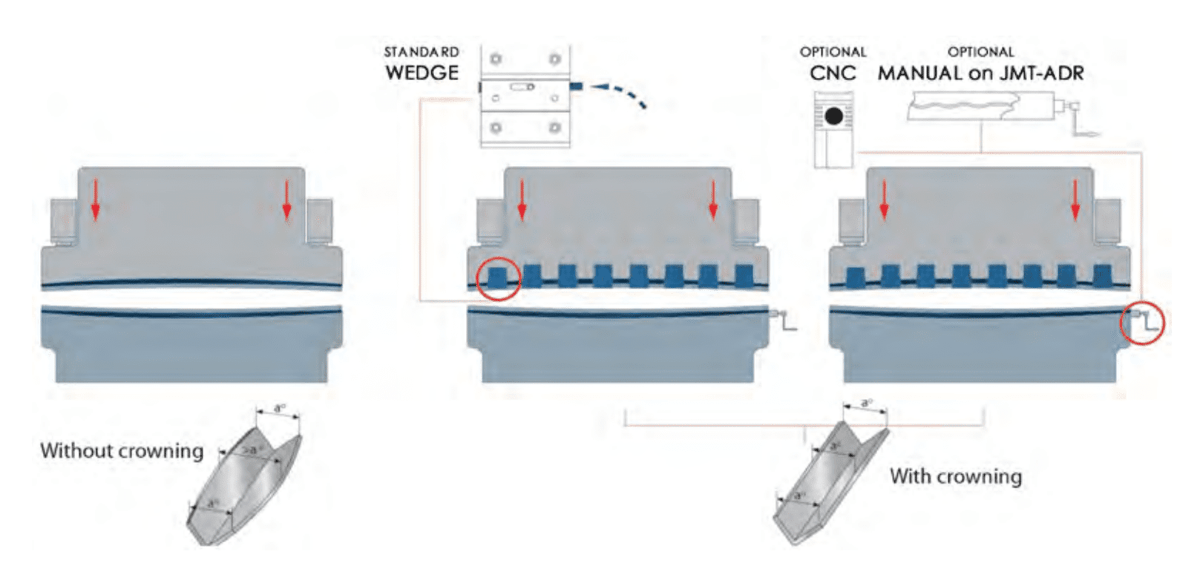Pressione o freio coroamento é uma técnica usada em metalurgia, particularmente no processo de dobra, para garantir resultados consistentes e precisos ao dobrar chapas ou placas de metal. Quando uma chapa de metal é dobrada usando uma prensa dobradeira, ela tende a se deformar de forma previsível devido a fatores como elasticidade do material e variações de espessura. No entanto, essas deformações podem às vezes levar a imprecisões nos ângulos finais de dobra, especialmente na largura da chapa.
O coroamento envolve a modificação do formato da cama ou da ferramenta da prensa dobradeira para compensar essas deformações previsíveis. Normalmente, a cama ou a ferramenta é moldada levemente para formar uma curva convexa em todo o seu comprimento. Essa curvatura é projetada para neutralizar a deflexão antecipada da chapa metálica durante a dobra, resultando em ângulos de dobra mais uniformes em toda a largura da chapa.
A quantidade de coroamento necessária depende de fatores como o tipo de material, espessura e comprimento da chapa metálica que está sendo dobrada. O coroamento pode ser ajustado manualmente ou automaticamente com base nos requisitos específicos de cada trabalho de dobramento.
Ao empregar o coroamento, os fabricantes podem obter resultados de dobra mais precisos e consistentes, reduzindo o refugo, melhorando a qualidade geral do produto e minimizando a necessidade de operações secundárias para corrigir imprecisões nas peças dobradas.

O que é coroamento em prensas dobradeiras?
No contexto de freios de pressão, coroamento se refere à curvatura intencional ou ajuste feito na cama ou ferramental da máquina de prensa dobradeira. Esse ajuste é feito para compensar a deflexão natural que ocorre quando chapas grandes ou grossas de metal são dobradas.
Quando uma chapa de metal é dobrada em uma prensa dobradeira, a força aplicada pelo aríete da prensa dobradeira pode fazer com que a base da máquina flexione levemente. Essa flexão pode resultar em uma curvatura irregular ao longo do comprimento da chapa, com o centro sofrendo menos curvatura do que as bordas. Essa inconsistência pode levar a imprecisões na parte dobrada final.
Para neutralizar esse efeito, utiliza-se o coroamento. Ao ajustar a curvatura da cama ou ferramental, normalmente em formato convexo, o operador da prensa dobradeira pode compensar a deflexão antecipada. Isso garante que a força aplicada durante a dobra seja distribuída de forma mais uniforme pela largura da chapa, resultando em ângulos de dobra mais consistentes por toda a peça.
O coroamento é particularmente importante ao trabalhar com folhas de metal mais longas ou mais grossas, onde a deflexão pode ter um impacto mais significativo na precisão da dobra. Ele ajuda a minimizar o refugo, melhorar a qualidade do produto e reduzir a necessidade de correção manual de peças dobradas. As prensas dobradeiras modernas geralmente apresentam sistemas de coroamento automatizados que podem ajustar a curvatura dinamicamente com base em fatores como espessura do material e parâmetros de dobra.
A coroação pode ser prevenida?
Embora seja quase impossível eliminar completamente o coroamento, especialmente em peças longas de chapa metálica, existem métodos para mitigar seus efeitos. Isso inclui várias técnicas de compensação que se ajustam à deformação que o coroamento causa, garantindo dobras precisas, apesar da flexão inerente da máquina.
Formas de compensar o coroamento da prensa dobradeira
Existem várias maneiras de compensar o abaulamento da prensa dobradeira para garantir resultados de dobra precisos e consistentes:
Ajuste manual: Os operadores de prensas dobradeiras podem ajustar manualmente o coroamento calçando as matrizes ou a base da prensa dobradeira. Isso envolve adicionar ou remover calços para alterar a curvatura da ferramenta ou da base, compensando a deflexão.
Sistemas de coroamento hidráulico: Muitas prensas dobradeiras modernas são equipadas com sistemas de coroamento hidráulico. Esses sistemas usam atuadores hidráulicos para ajustar a curvatura da cama ou ferramental automaticamente. Eles podem ser programados para compensar variações na espessura do material e nos parâmetros de dobra.
Compensação Mecânica: Algumas prensas dobradeiras usam mecanismos mecânicos para compensar o coroamento. Isso pode envolver cunhas ou parafusos ajustáveis que podem ser apertados ou afrouxados para alterar a curvatura da cama ou ferramental.
Compensação de software: Sistemas avançados de controle de freio de prensa podem incorporar algoritmos de compensação baseados em software. Esses algoritmos analisam fatores como propriedades do material, comprimento da dobra e força de dobra para calcular o ajuste de coroamento necessário automaticamente.
Seleção de matrizes: Escolher o formato e o tamanho apropriados da matriz também pode ajudar a compensar o coroamento. Certos designs de matriz, como matrizes segmentadas ou de raio variável, podem distribuir as forças de flexão de forma mais uniforme pela largura da folha, reduzindo a necessidade de ajustes de coroamento.
Pré-dobramento de material: Pré-dobrar o material ligeiramente antes da operação de dobra real pode ajudar a compensar os efeitos de coroamento. Isso envolve dobrar o material na direção oposta da dobra final para neutralizar qualquer curvatura ou deflexão inerente.
Compensação de espessura do material: Ajustar os parâmetros de curvatura, como a tonelagem e o raio de curvatura, com base na espessura do material pode ajudar a compensar o abaulamento. Materiais mais espessos tendem a desviar mais, então aplicar força adicional ou usar raios de curvatura maiores pode ajudar a mitigar esse efeito.
Mantendo seu sistema de coroamento
Ao empregar essas técnicas de compensação, os operadores de prensas dobradeiras podem garantir que o coroamento não tenha impacto negativo na precisão ou consistência de suas operações de dobra, resultando em peças acabadas de alta qualidade.
A manutenção do seu sistema de coroamento é crucial para garantir seu desempenho e longevidade contínuos. A manutenção regular inclui inspeção frequente e — em sistemas de coroamento do tipo cunha — lubrificação da cunha para mantê-los operando de forma suave e eficaz.
Entender o coroamento de prensas dobradeiras e as várias maneiras de compensá-lo é essencial para obter dobras precisas em todas as suas operações de prensas dobradeiras. Lembre-se de fazer a manutenção regular do seu sistema de coroamento para garantir o desempenho ideal e a vida útil prolongada do equipamento.



